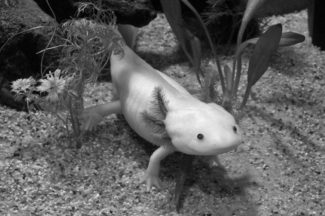
Axolotl: The Aliens of Mexico
By Leslie Delgado
SUST 125: Introduction to Global Sustainability
During our Introduction to Sustainability course, students explore their connections to the natural world around them in several assignments. Leslie delighted in exploring and sharing her cultural and natural connections to the Ambystoma dumerilii, or axolotl, in this nature journal entry.
-Paulina Mena, Sue Pagnac, and Mary Stark
Alien Salamanders exist in Mexico. Curious? Well, this “alien salamander” is named the axolotl, or Ambystoma dumerilii, and has been a prized Mexican icon for centuries, but they are on the bridge to extinction. I first heard of their existence through a classmate on my marine biology trip to Galveston, Texas. He showed pictures of the creature and answered any questions I had. After he said they were endemic to Mexico, I quickly became more excited and intrigued with the axolotl. I almost felt a sense of embarrassment because I, the daughter of Mexican immigrants, didn’t know about them, but a kid from small town Iowa did. Nevermind the self-doubt, have you seen these creatures? They are the cutest, scariest, most interesting creatures we will ever see.
The Axolotl is only found specifically in the Lake region, Xochimilco, just south of Mexico City. Dionisio Eslava, at the museum Umbral Axochiatl, confirms that they are pronounced (Ah- HO- loe- tae) in Spanish and are named after an Aztec god. Although the creature is beautiful, the axolotl also has a deep history to Mexican culture. Eslava states that at the beginning of time, the Aztec gods sat around a fire to sacrifice themselves to give their sacred souls to an element, such as soil or water. One of the gods, Xolotl (SHO- lot) refused to throw himself in the fire. His brother Quetzalcoatl demanded he be sacrificed, but Xolotl resisted. He suffered many shape shifts and found himself at lake Xochimilco, eventually turning into an Axolotl. His brother then spared his life but punished the god by having him live in darkness forever as a water monster. Axolotl differ from other salamanders because they remain in their larval phase and don’t experience metamorphosis. According to Dr. Mena, biology professor of Central College in Pella Iowa, this phenomenon is called “neotenia”. They can also regenerate any body part that is wounded or severed, which is unique. Axolotls can produce eggs at a high rate, but the struggle is to keep them alive in the wild. Dr Erika Servin Zamora, Axolotl vet and author of Mi ajolote en casa, says, “In Mexico, there are 17 different species of Axolotls and all except for one species are in an endangered category.”
Many factors have contributed to the Axolotl’s endangered status. The main reason is the inappropriate introduction of exotic species of fish, like mojarra and carp, to the lake, which makes the Axolotl a target prey. Also, because Mexico City is so close by, its polluted water pours into Xochimilco’s waters through runoff, making it hard for the Axolotls to adapt quickly (Zambrano). Mexico City is built on water because they are literally on top of the water; one can imagine how many chemical pollutants contaminate the freshwaters of Xochimilco.
According to professor Luis Zambrano of National Autonomous University of Mexico, “By 2025, they [axolotls] will be extinct if we don’t do anything” (BBC News). Although it is a tragedy that they are struggling in the wild, only a few organizations specialize in the repopulation of the Axolotls. The beauty of Mexico is its fusion of religion and traditional culture; according to the BBC news, nuns nearby Patzcuaro, who belong to the Monastery of the Dominican Order, host a conservation organization breeding the creatures, not only to keep the population alive, but also to make cough syrup. Although this hasn’t been proven yet, the Axolotl is believed to have healing powers that can help with cough, bronchitis, and asthma. The nuns have years of experience of breeding axolotls and helping the scientists better understand their growth patterns–eventually using that knowledge and data to help restore the axolotl population.
Ever since I was introduced to these amazing creatures, I have been spiritually attracted to the animals. I am intrigued by the religious and spiritual meanings for the Axolotl as well. Who would’ve thought these creatures were connected to a cursed Aztec god? That is what’s amazing about this whole situation: culture and religion surround this compelling, endemic creature. I will be visiting my family in Mexico and will definitely make efforts to visit the axolotl museum and conservation lab. We cannot turn our heads away from their suffering. As the axolotl becomes critically endangered, we must do our part to spread the word and attempt to contribute towards conservation efforts. But the question is, will attempts be enough to save them?
Works Cited
Dionisio, Eslava. National Geographic. (2016, October 18). Named for an Aztec God, This Species Is Critically Endangered | National Geographic. YouTube. https:/ www.youtube.com/watch?v=lL87xhk63FM.
Mena, Paulina. Interview June 22, 2021.
TEDEducation. (2021, June 22). Axolotls: The salamanders that snack on each other (but don’t die) – Luis Zambrano. YouTube. Retrieved from https://www.youtube.com/watch?v=uooR4293p_4.
Zalisko, E. (2019, December 21). Ask dr. Universe: What are axolotl? The Daily World. Retrieved from https://www.thedailyworld.com/life/ ask-dr-universe-what-are-axolotl/.
Zambrano, Luis. et al. bbc news. (2018, June 6). Meet the nuns saving a sacred species from extinction – BBC News. YouTube. https://www.youtube.com/watch?v=YfRMhBzkUbE. Zachos, E. (2018, June 19).
Mexican nuns work to save endangered salamander. National Geographic. Retrieved from https://www.nationalgeographic.com/animals/article/ salamander-conservation-nuns-mexico-animals.

